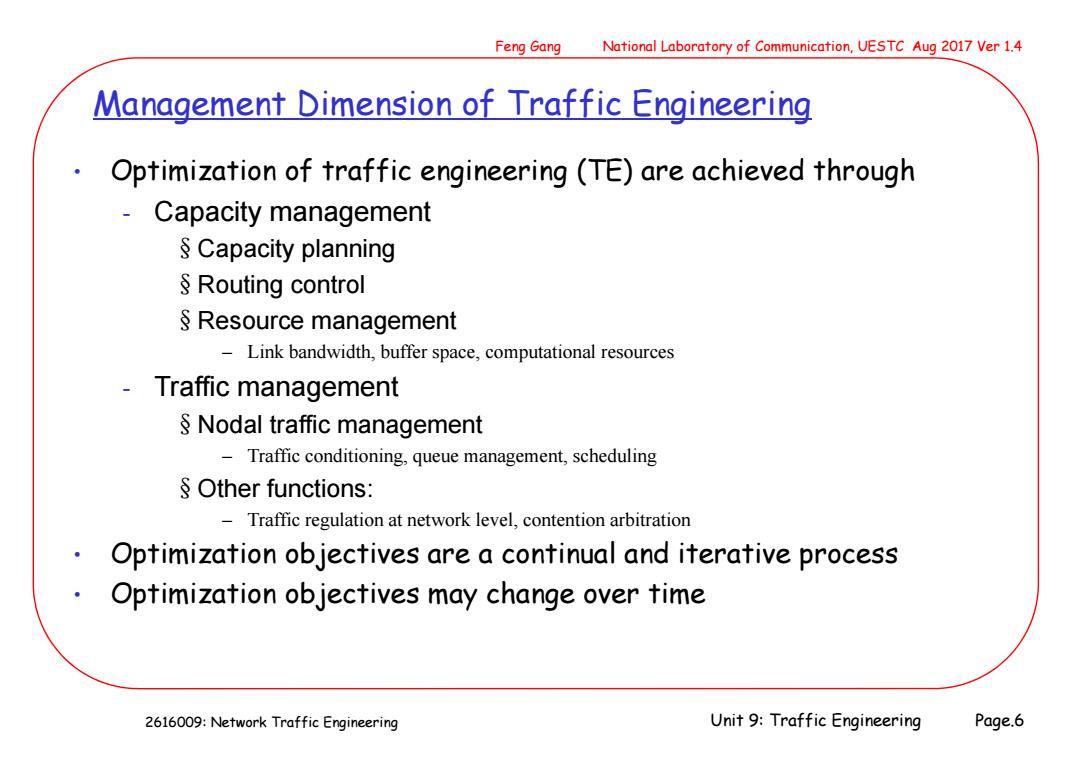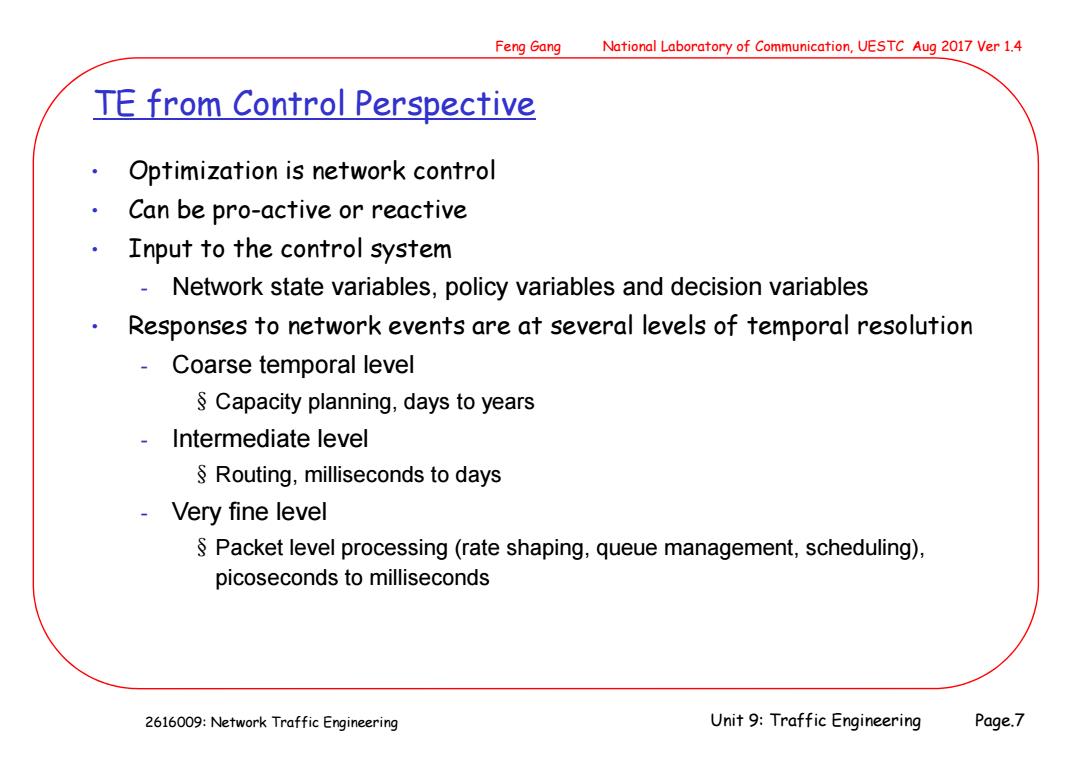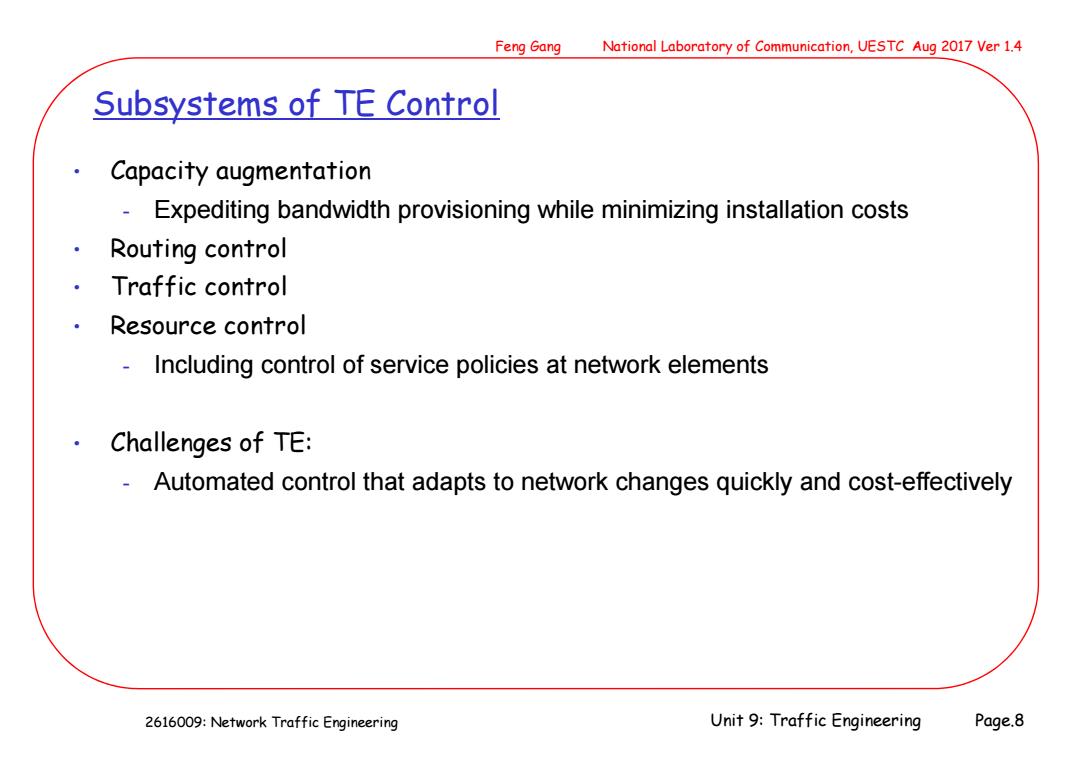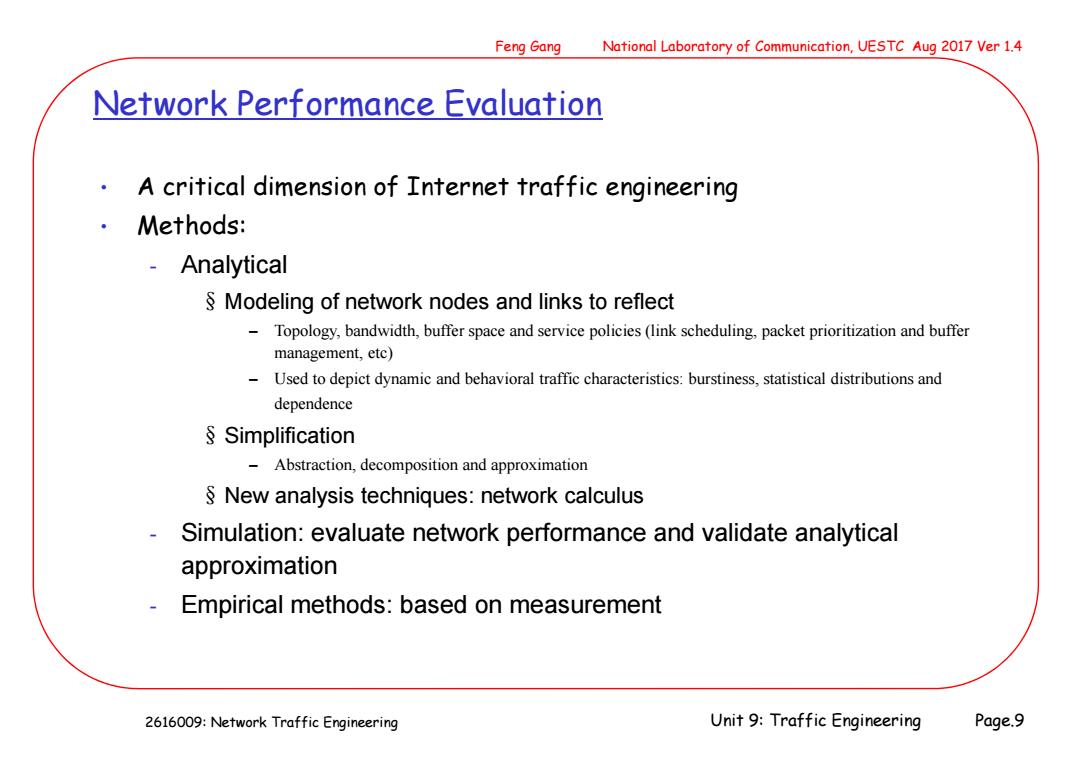
Feng Gang National Laboratory of Communication,UESTC Aug 2017 Ver 1.4 Management Dimension of Traffic Engineering 。 Optimization of traffic engineering(TE)are achieved through Capacity management §Capacity planning §Routing control §Resource management Link bandwidth,buffer space,computational resources Traffic management Nodal traffic management Traffic conditioning,queue management,scheduling §Other functions: Traffic regulation at network level,contention arbitration Optimization objectives are a continual and iterative process Optimization objectives may change over time 2616009:Network Traffic Engineering Unit 9:Traffic Engineering Page.6
2616009: Network Traffic Engineering Feng Gang National Laboratory of Communication, UESTC Aug 2017 Ver 1.4 Unit 9: Traffic Engineering Page.6 Management Dimension of Traffic Engineering • Optimization of traffic engineering (TE) are achieved through - Capacity management §Capacity planning §Routing control §Resource management – Link bandwidth, buffer space, computational resources - Traffic management §Nodal traffic management – Traffic conditioning, queue management, scheduling §Other functions: – Traffic regulation at network level, contention arbitration • Optimization objectives are a continual and iterative process • Optimization objectives may change over time

Feng Gang National Laboratory of Communication,UESTC Aug 2017 Ver 1.4 TE from Control Perspective Optimization is network control Can be pro-active or reactive Input to the control system Network state variables,policy variables and decision variables Responses to network events are at several levels of temporal resolution Coarse temporal level S Capacity planning,days to years Intermediate level Routing,milliseconds to days Very fine level S Packet level processing (rate shaping,queue management,scheduling), picoseconds to milliseconds 2616009:Network Traffic Engineering Unit 9:Traffic Engineering Page.7
2616009: Network Traffic Engineering Feng Gang National Laboratory of Communication, UESTC Aug 2017 Ver 1.4 Unit 9: Traffic Engineering Page.7 TE from Control Perspective • Optimization is network control • Can be pro-active or reactive • Input to the control system - Network state variables, policy variables and decision variables • Responses to network events are at several levels of temporal resolution - Coarse temporal level §Capacity planning, days to years - Intermediate level §Routing, milliseconds to days - Very fine level §Packet level processing (rate shaping, queue management, scheduling), picoseconds to milliseconds

Feng Gang National Laboratory of Communication,UESTC Aug 2017 Ver 1.4 Subsystems of TE Control Capacity augmentation Expediting bandwidth provisioning while minimizing installation costs Routing control 。 Traffic control 。 Resource control Including control of service policies at network elements ·Challenges of TE: Automated control that adapts to network changes quickly and cost-effectively 2616009:Network Traffic Engineering Unit 9:Traffic Engineering Page.8
2616009: Network Traffic Engineering Feng Gang National Laboratory of Communication, UESTC Aug 2017 Ver 1.4 Unit 9: Traffic Engineering Page.8 Subsystems of TE Control • Capacity augmentation - Expediting bandwidth provisioning while minimizing installation costs • Routing control • Traffic control • Resource control - Including control of service policies at network elements • Challenges of TE: - Automated control that adapts to network changes quickly and cost-effectively

Feng Gang National Laboratory of Communication,UESTC Aug 2017 Ver 1.4 Network Performance Evaluation A critical dimension of Internet traffic engineering 。 Methods: Analytical S Modeling of network nodes and links to reflect -Topology,bandwidth,buffer space and service policies(link scheduling,packet prioritization and buffer management,etc) -Used to depict dynamic and behavioral traffic characteristics:burstiness,statistical distributions and dependence §Simplification -Abstraction,decomposition and approximation S New analysis techniques:network calculus Simulation:evaluate network performance and validate analytical approximation Empirical methods:based on measurement 2616009:Network Traffic Engineering Unit 9:Traffic Engineering Page.9
2616009: Network Traffic Engineering Feng Gang National Laboratory of Communication, UESTC Aug 2017 Ver 1.4 Unit 9: Traffic Engineering Page.9 Network Performance Evaluation • A critical dimension of Internet traffic engineering • Methods: - Analytical §Modeling of network nodes and links to reflect – Topology, bandwidth, buffer space and service policies (link scheduling, packet prioritization and buffer management, etc) – Used to depict dynamic and behavioral traffic characteristics: burstiness, statistical distributions and dependence §Simplification – Abstraction, decomposition and approximation §New analysis techniques: network calculus - Simulation: evaluate network performance and validate analytical approximation - Empirical methods: based on measurement

Feng Gang National Laboratory of Communication,UESTC Aug 2017 Ver 1.4 Traffic Engineering Process Control policies definition Measurement data acquisition Performance analysis Performance Optimization 2616009:Network Traffic Engineering Unit 9:Traffic Engineering Page.10
2616009: Network Traffic Engineering Feng Gang National Laboratory of Communication, UESTC Aug 2017 Ver 1.4 Unit 9: Traffic Engineering Page.10 Control policies definition Traffic Engineering Process Measurement data acquisition Performance analysis Performance Optimization